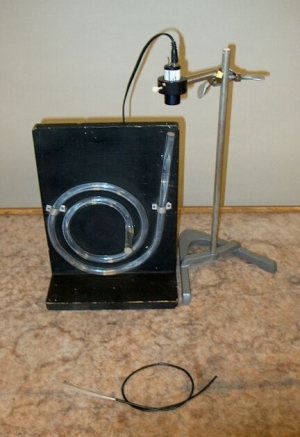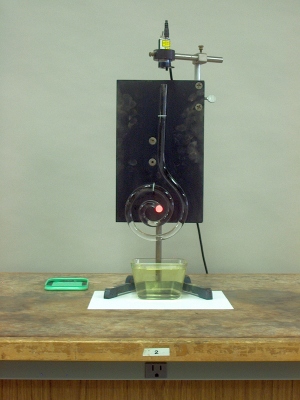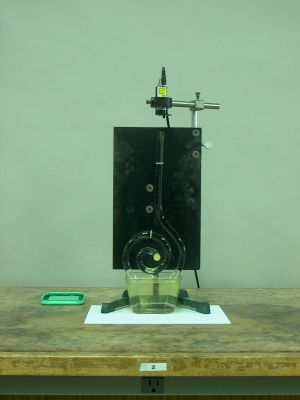 |
 |
 |
 |
 |
 |
A laser beam enters one end of a transparent Plexiglas® rod shaped into a spiral. Because it suffers total internal reflection wherever its path meets the wall of the spiral, it can travel all the way through the spiral, appearing at the other end. You can also place one end of the bundle of optical fibers (shown in the photograph at left) underneath the laser, and show the class that the light emerges from the end of each of the fibers at the end where the cladding has been removed. In addition, with the apparatus shown in the photographs in the center and on the right, you can lower the bottom loop of the spiral into corn oil, whose index of refraction matches that of the Plexiglas®. (The apparatus is held to the stand by means of a clamp on its back, which you can loosen and tighten by means of a thumbscrew.) As you do this, more and more of the light exits into the corn oil until, when the entire diameter of the loop is in the corn oil, no light emerges from the end of the spiral.
This demonstration is to provide a graphic illustration of the phenomenon of total internal reflection, which occurs when light meets the interface between the medium in which it is traveling and another that has a lower index of refraction, at an angle above the critical angle. (See demonstration 80.18 – Refraction tank.) The critical angle is the angle of incidence at which the angle of refraction equals 90°, and thus, the angle at or above which there cannot be any refracted ray. At or above this angle, then, the light suffers total internal reflection. In the spirals in this demonstration, the light can travel through the straight part before the spiral, but as soon as the spiral bends, the light hits the wall of the spiral. Since it meets the wall at an angle that exceeds the critical angle, it suffers total internal reflection. It then undergoes multiple such reflections until it emerges at the far end of the spiral, where we see the illuminated exit face of the spiral. In similar fashion, if you hold the end of the fiber optic bundle (the end that still has the cladding) beneath the laser module, light travels through each fiber, and you can show the class the multiple illuminated fiber ends. For added effect, the fiber bundle is tied into a loose knot.
If, at some point along the Plexiglas® spiral, you place it in a medium whose index of refraction equals (or is greater than) that of the Plexiglas®, the light can then exit the spiral into the other medium. (If the indices equal, there should be no reflection; if the index of the second medium is greater than in the Plexiglas®, then some light is reflected.) So, with the apparatus shown in the center and right photographs above, as you lower the spiral into the corn oil below, the light begins to exit the spiral where it meets the corn oil, until, when you have completely covered the bottom loop of the spiral, no light emerges from the end. The index of refraction of the corn oil is very close to that of the Plexiglas®, so where the spiral meets the corn oil, there is no reflection, and the light travels into the corn oil. It is good to have a white piece of paper underneath the container of corn oil, to make it easier to see the light that has exited the spiral through the corn oil.